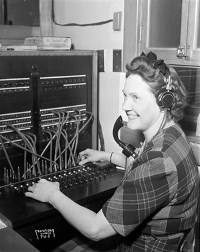What is a PBX
A private branch exchange (PBX) is a telephone exchange that connects telephones and other communication devices amongst themselves in a private network and connects those devices to the public switched telephone network (PSTN).
During the first half of the 20th century when the Bell System monopoly on telecommunications was total, phone service was a near luxury item. The idea of a business or agency providing dedicated phone lines for it's employees was cost prohibitive.

In the early days, a switchboard operator manually connected calls in a PBX.
The creative moment for PBXs came when someone recognized that for medium to large businesses, most calls tend to be internal amongst employees. A company might have 100 employees needing telephones but at any given time, no more than perhaps 5 of them would be engaged in a call outside their own private network.
For these type usage scenarios, purchasing perhaps 10 dedicated lines from the telephone company, connecting them to a PBX and employing switchboard operators to manage them was seen as the most cost effective means of providing phone service to all employees in need of such service.
In these early days of telephony, an operator sat at a switchboard and manually made connections among telephones within the exchange. The switchboard operator also connected calls between the PSTN and telephones within the private exchange.
Using modern terminology, telephones connected to the PBX looked like members of a subtended network and the PBX switchboard operator resembled the subtending host. A PBX could also be seen as a gateway between a private network and public network. Certain aspects of a PBX also resemble the function provided by a network hub.
As technology progressed, the manual switchboard operators gave way to increasingly automated electromechanical switching systems which in turn were replaced by electronic switching systems.
The advent of private electronic switching systems introduced the term private automatic branch exchange (PABX) where the letter A in PABX represented automatic. In the 1980's as digital PABX's came to market, the letter "A" in PABX became increasingly regarded as meaning analog and was largely dropped in favor of PBX being used to represent a modern digital private branch exchange.
Prior to the internet age, digital PBXs were heralded as platforms of choice for the convergence of voice and data communications. Most major international telephone equipment vendors were trying to get in on the expected wave of North American business but didn't realize they were preparing for the wrong wave.
When the wave came, it was an internet wave most traditional telecommunications vendors were unprepared to ride.
The introduction of IP based computer telophony in the 1990's created fresh rounds of innovation as data communication companies developed packet based methods of voice communications over corporate LANs. These integrated voice and data communication systems are commonly referred to as business communication systems but to date, no abbreviation has been able to convey the unique communications role of a PBX.




